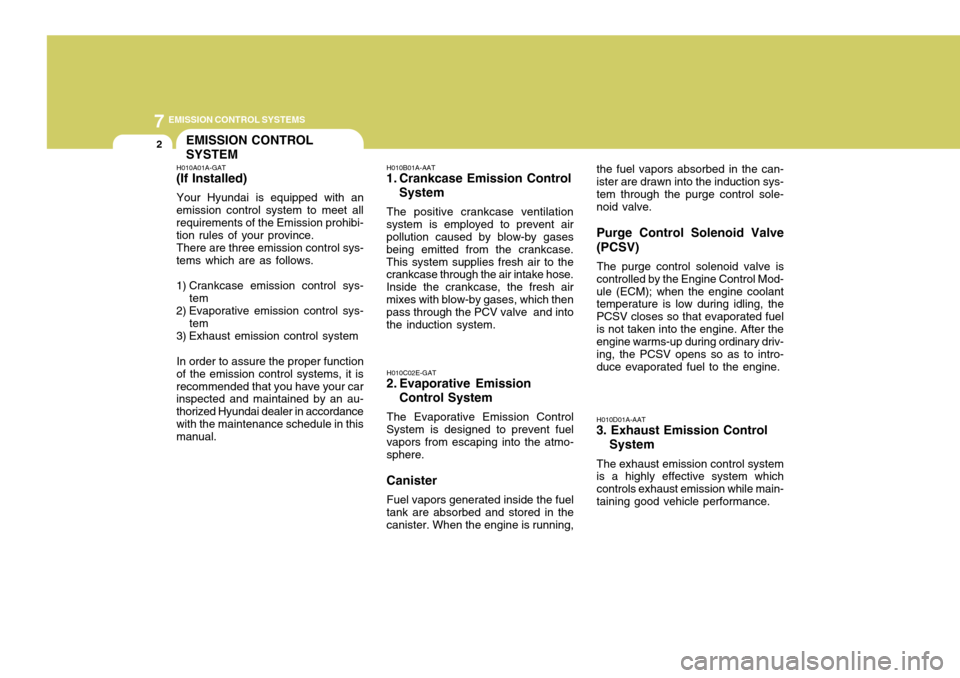Page 14 of 284

1FEATURES OF YOUR HYUNDAI
2FUEL RECOMMENDATIONS
B010A02MC-GAT Use Unleaded Gasoline If leaded gasoline is used, it will cause the catalytic converter to become inef-fective and the emission control sys- tem to malfunction. This can also result in increased maintenance expense. Toavoid accidental use of leaded fuel, the large nozzle used with leaded gasoline at service stations can not be insertedinto fuel tank opening of Hyundai ve- hicle. NOTE:
o For some countries, Hyundai ve-
hicles are designed to use leaded gasoline. When you are going touse leaded gasoline, ask to Hyundai dealer whether leaded gasoline in your vehicle is avail-able or not.
o Octane Rating of leaded gasoline
is same with unleaded one.
For Europe
– For the optimal vehicle
performance, we recommend you to use unleaded gasoline with an octane rating of RON (Research Octane Num-ber) 95 /AKI (Anti Knock Index) 91 or higher. You may use unleaded gasoline with anoctane rating of RON 91~94/AKI 87~90 but it may result in slight performance reduction of the vehicle. Except Europe – Unleaded gasoline
with a Pump Octane Rating of 87 (Re- search Octane Number 91) or higher must be used in Hyundai vehicle. B010A01MC
Use Diesel Diesel fuel Diesel engine must be operated only on commercially available diesel fuel that complies with EN 590 or comparablestandard. (EN stands for "European Norm"). Do not use marine diesel fuel, heatingoils, or non-approved fuel additives, as this will increase wear and cause dam- age to the engine and fuel system. Theuse of non-approved fuels and / or fuel additives will result in a limitation of your warranty rights.Diesel fuel of above cetane 52 is used in Hyundai vehicle. If two types of diesel fuel are available, use summer orwinter fuel properly according to the following temperature conditions.
o Above -5°C (23°F) ... Summer type
diesel fuel.
o Below -5°C (23°F) ... Winter type diesel fuel.
Watch the fuel level in the tank very carefully : If the engine stops through fuel failure, the circuits must be com- pletely purged to permit restarting.
Page 76 of 284

1FEATURES OF YOUR HYUNDAI
64
B260N01MC-GATMalfunction Indicator Light (If Installed)
This light illuminates when there is a malfunction of an exhaust gas relatedcomponent, and the system is not func- tioning properly so that the exha ust gas
regulation values are not satisfied. This light will also illuminate when the ignition
key is turned to the "ON" position, and then it will go out in a few seconds after
the engine is started. If it illuminates
while driving, or does not illuminate whenthe ignition key is turned to the "ON"position, take your car to your nearest authorized Hyundai dealer and have the system checked.
B260M01A-AAT Low Fuel Level Warning Light
The low fuel level warning light comes on when the fuel tank is approaching empty. When it comes on, you shouldadd fuel as soon as possible. Driving with the fuel level warning light on or with the fuel level below "E" can causethe engine to misfire and damage the catalytic converter.
B260K01MC-AAT Trunk Lid/Tail Gate
Open Warning Light
This light remains on unless the trunk lid/tail gate is completely closed and latched.B260L01A-GAT Door Ajar Warning Light
The door ajar warning light warns you that a door is not completely closed.
B260L02HP-GAT Door Ajar Warning Light and Chime (Mideast only)
The door ajar warning light warns you that a door is not completely closed and the chime warns you that the key is inthe ignition switch. NOTE : The warning chime only sounds whenever the key is in the ignition switch and the driver's side frontdoor is open simultaneously. The chime sounds until the key is re- moved from the ignition switch orthe driver's side front door is closed.
Page 266 of 284

7EMISSION CONTROL SYSTEMS
2EMISSION CONTROL SYSTEM
H010A01A-GAT
(If Installed)
Your Hyundai is equipped with an
emission control system to meet all requirements of the Emission prohibi- tion rules of your province. There are three emission control sys-
tems which are as follows.
1) Crankcase emission control sys- tem
2) Evaporative emission control sys-
tem
3) Exhaust emission control system
In order to assure the proper function
of the emission control systems, it is recommended that you have your car inspected and maintained by an au- thorized Hyundai dealer in accordancewith the maintenance schedule in this manual. H010B01A-AAT
1. Crankcase Emission Control
System
The positive crankcase ventilation
system is employed to prevent airpollution caused by blow-by gases being emitted from the crankcase.This system supplies fresh air to the crankcase through the air intake hose. Inside the crankcase, the fresh airmixes with blow-by gases, which then pass through the PCV valve and into the induction system.
H010C02E-GAT
2. Evaporative Emission
Control System
The Evaporative Emission Control
System is designed to prevent fuelvapors from escaping into the atmo-sphere. Canister
Fuel vapors generated inside the fuel
tank are absorbed and stored in the canister. When the engine is running, the fuel vapors absorbed in the can-ister are drawn into the induction sys-tem through the purge control sole- noid valve. Purge Control Solenoid Valve (PCSV)
The purge control solenoid valve is
controlled by the Engine Control Mod- ule (ECM); when the engine coolant temperature is low during idling, the PCSV closes so that evaporated fuelis not taken into the engine. After the engine warms-up during ordinary driv- ing, the PCSV opens so as to intro-duce evaporated fuel to the engine. H010D01A-AAT
3. Exhaust Emission Control
System
The exhaust emission control system is a highly effective system which controls exhaust emission while main-taining good vehicle performance.